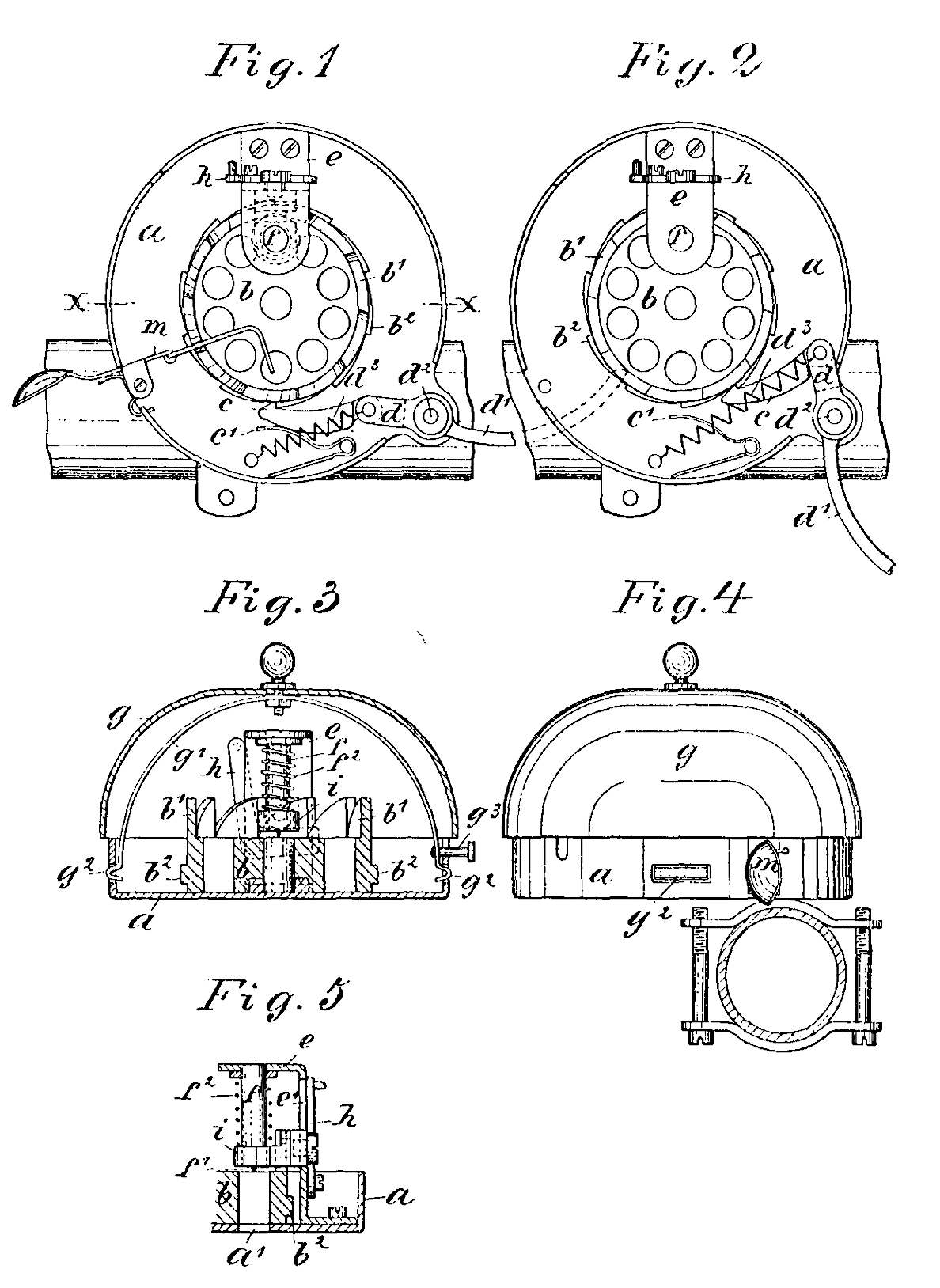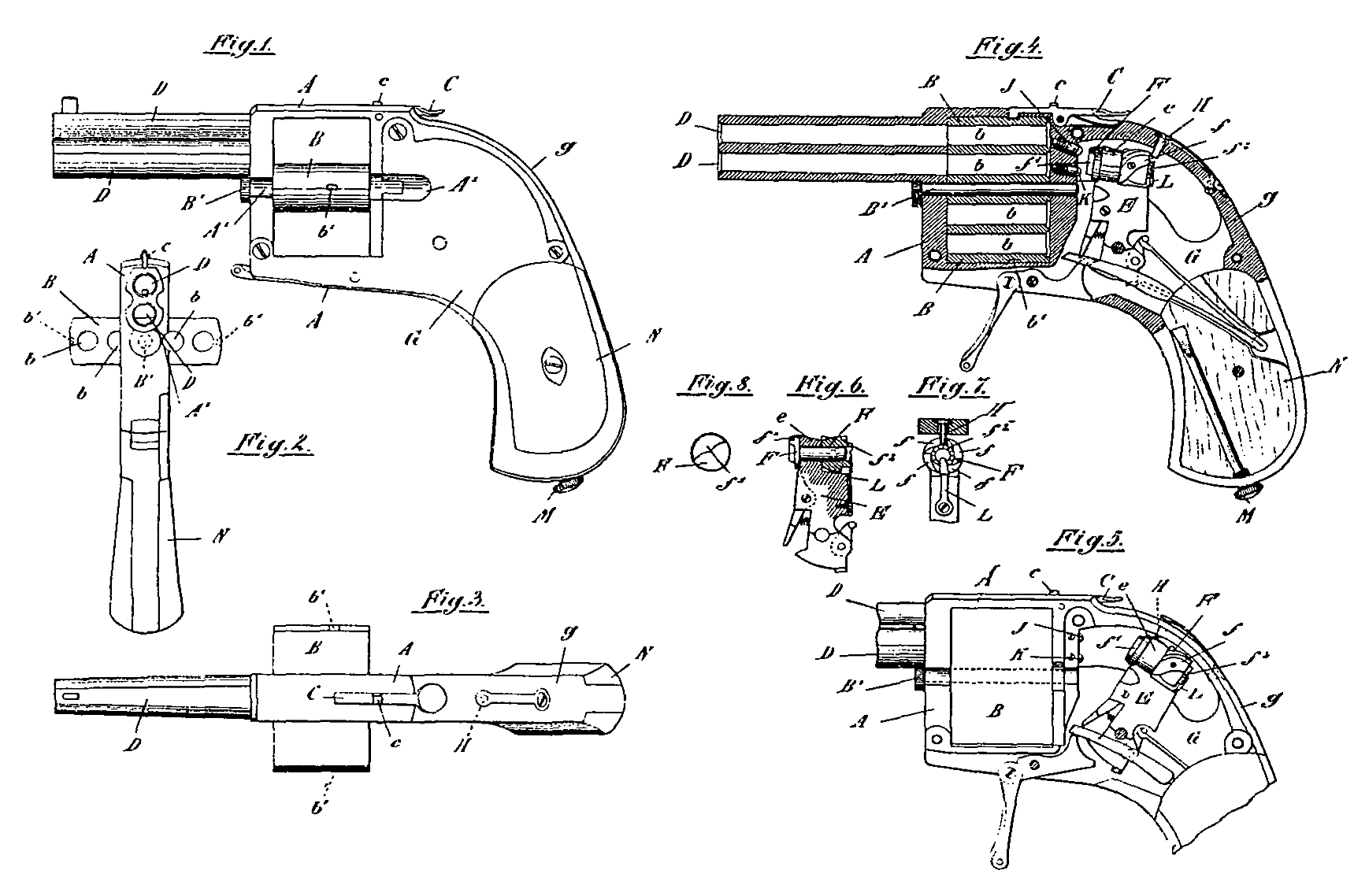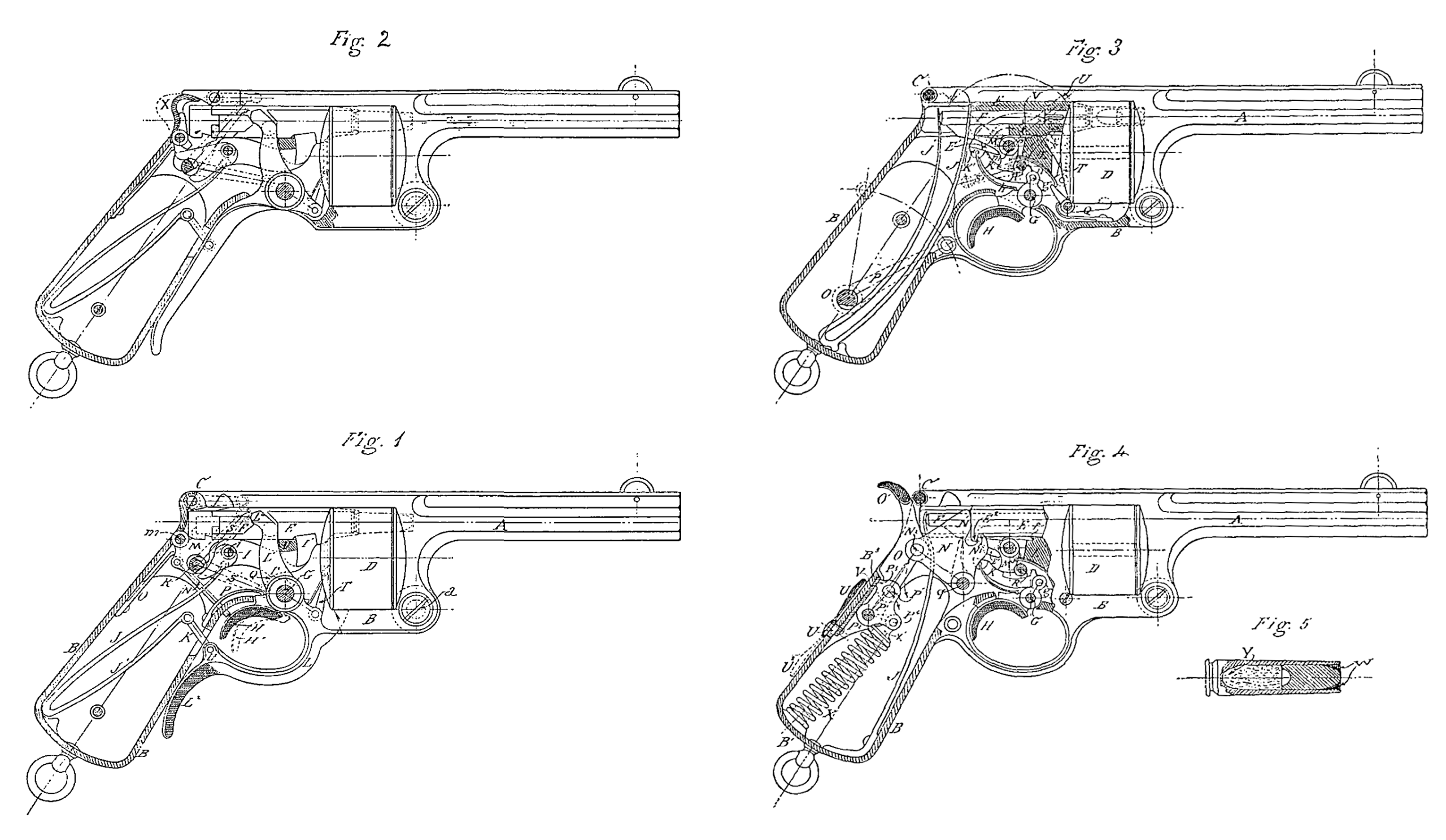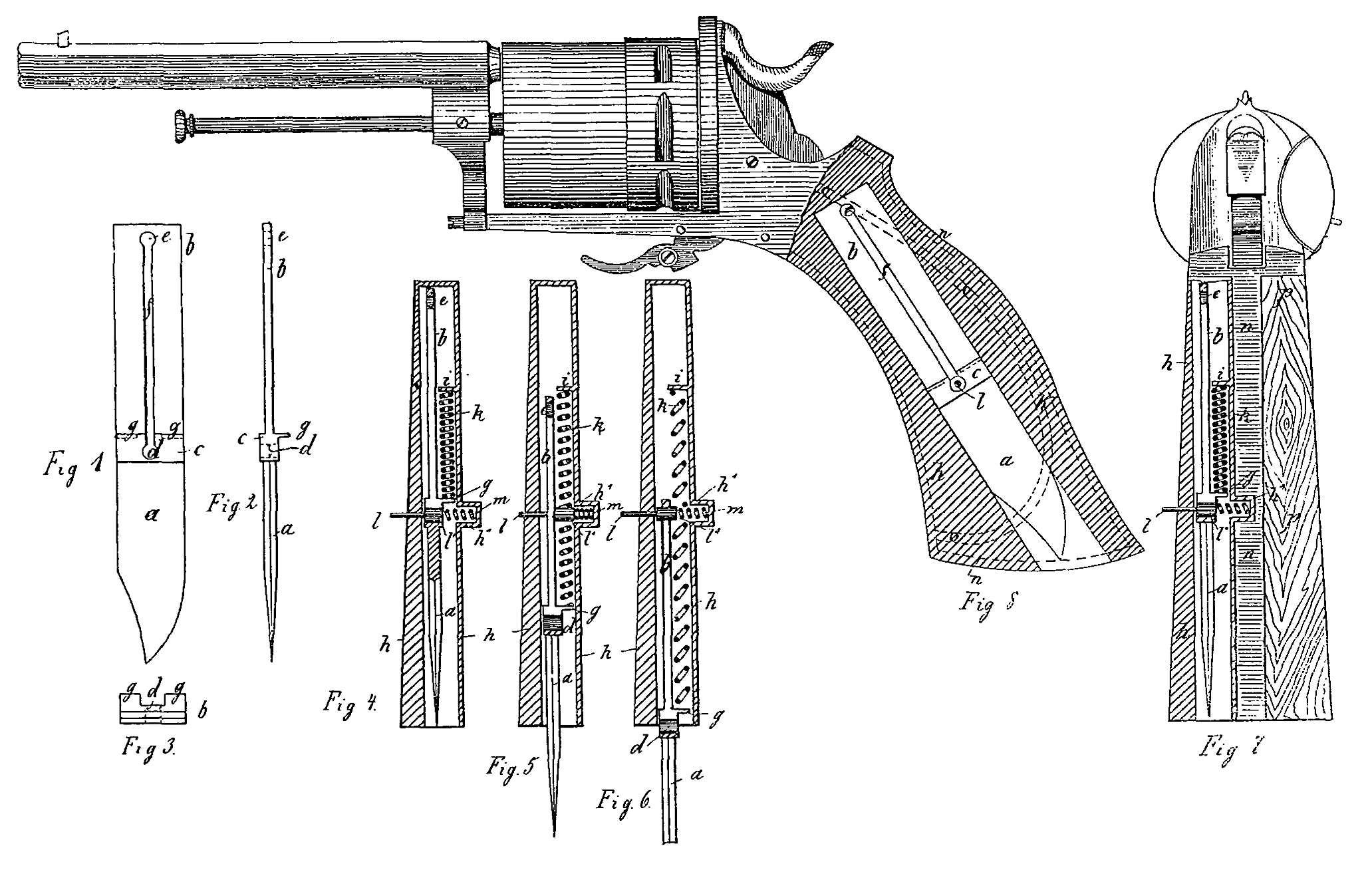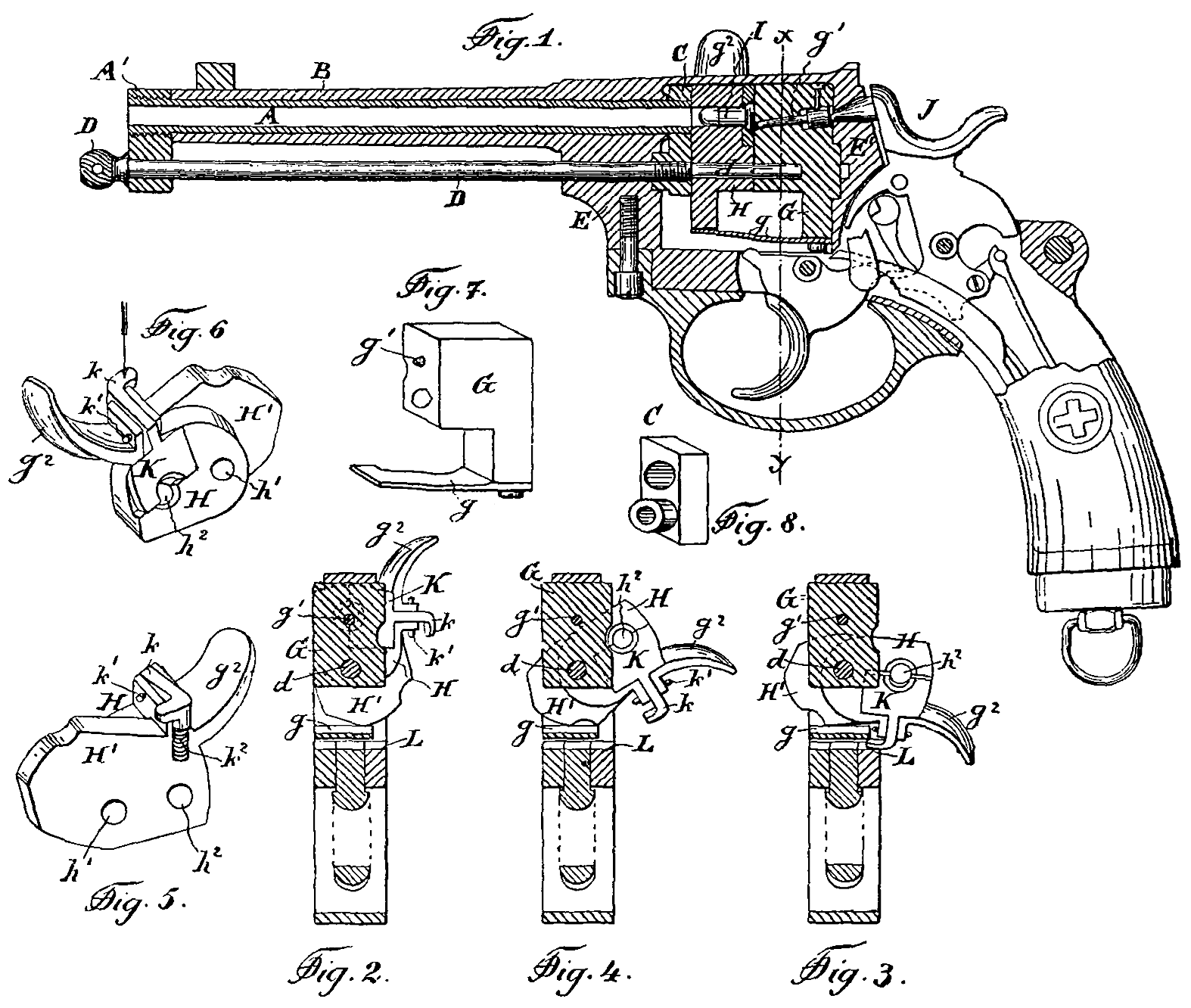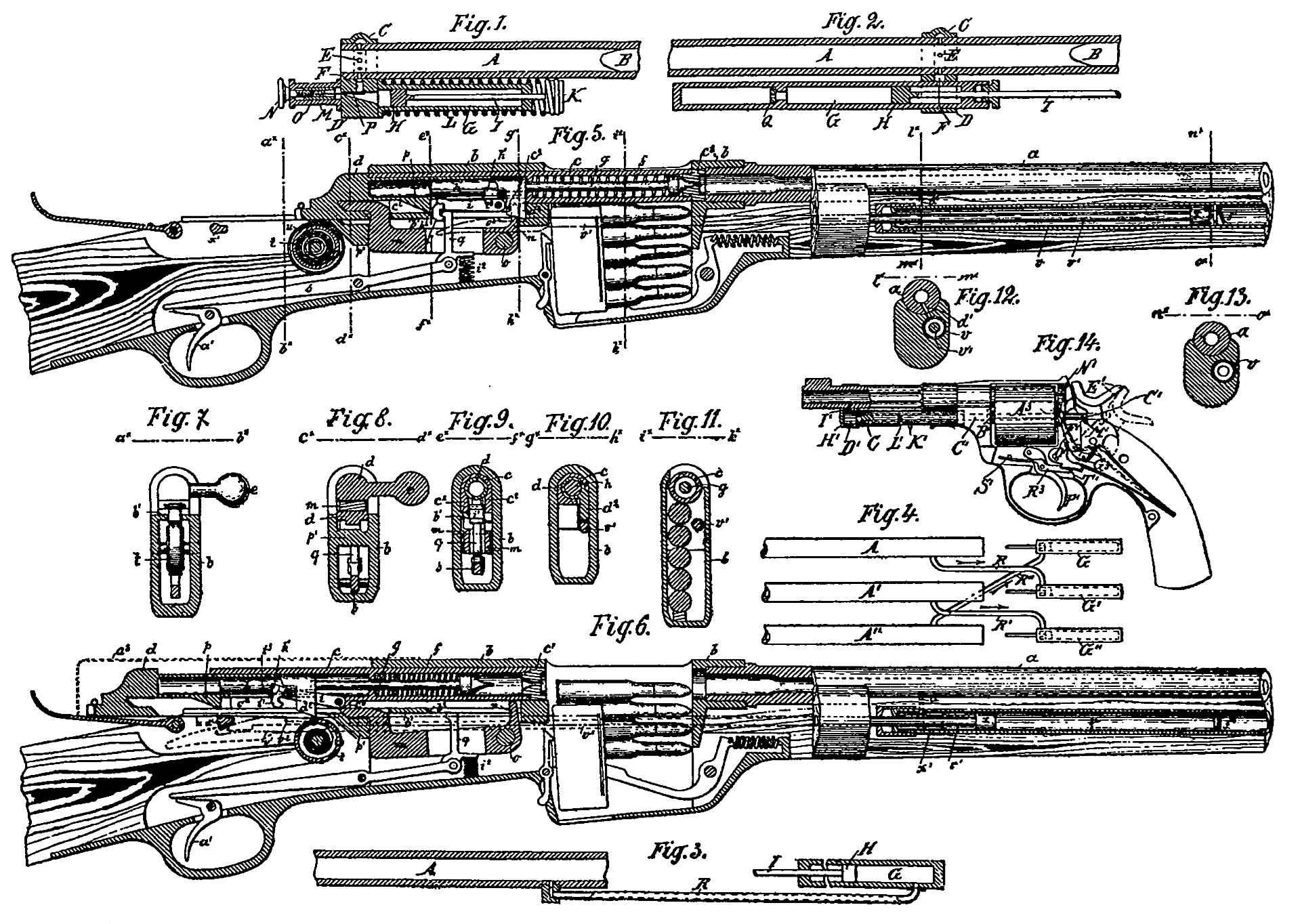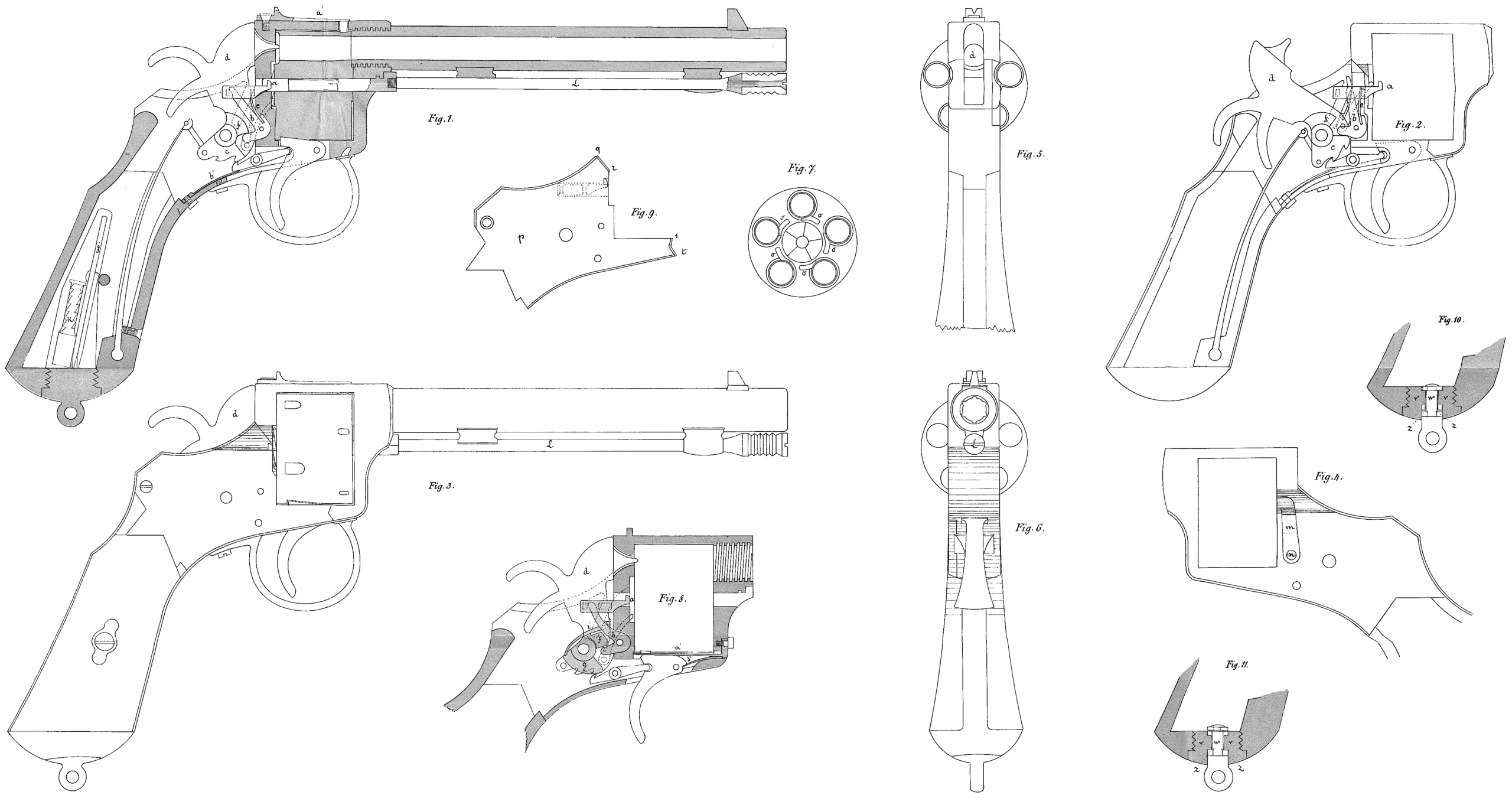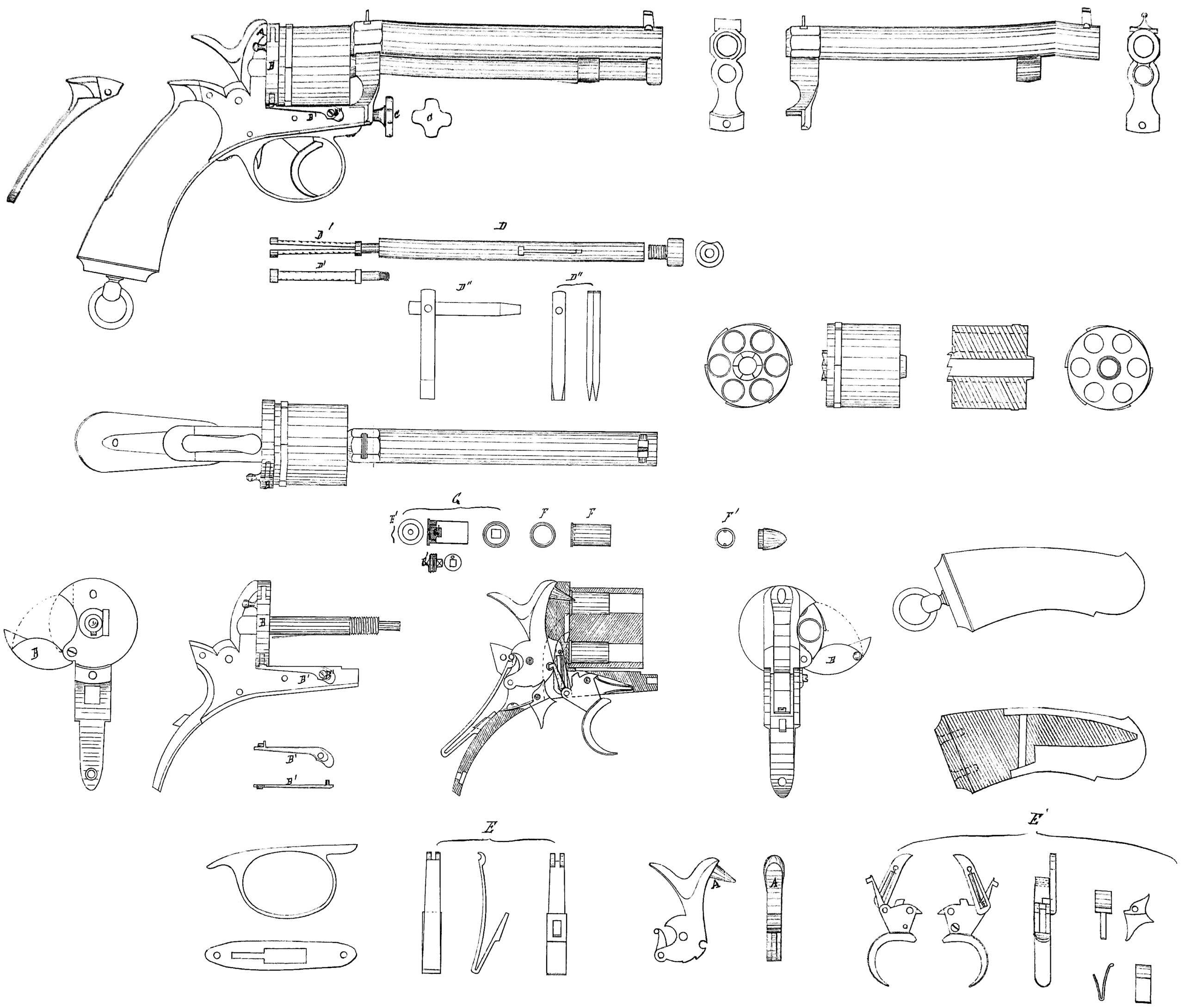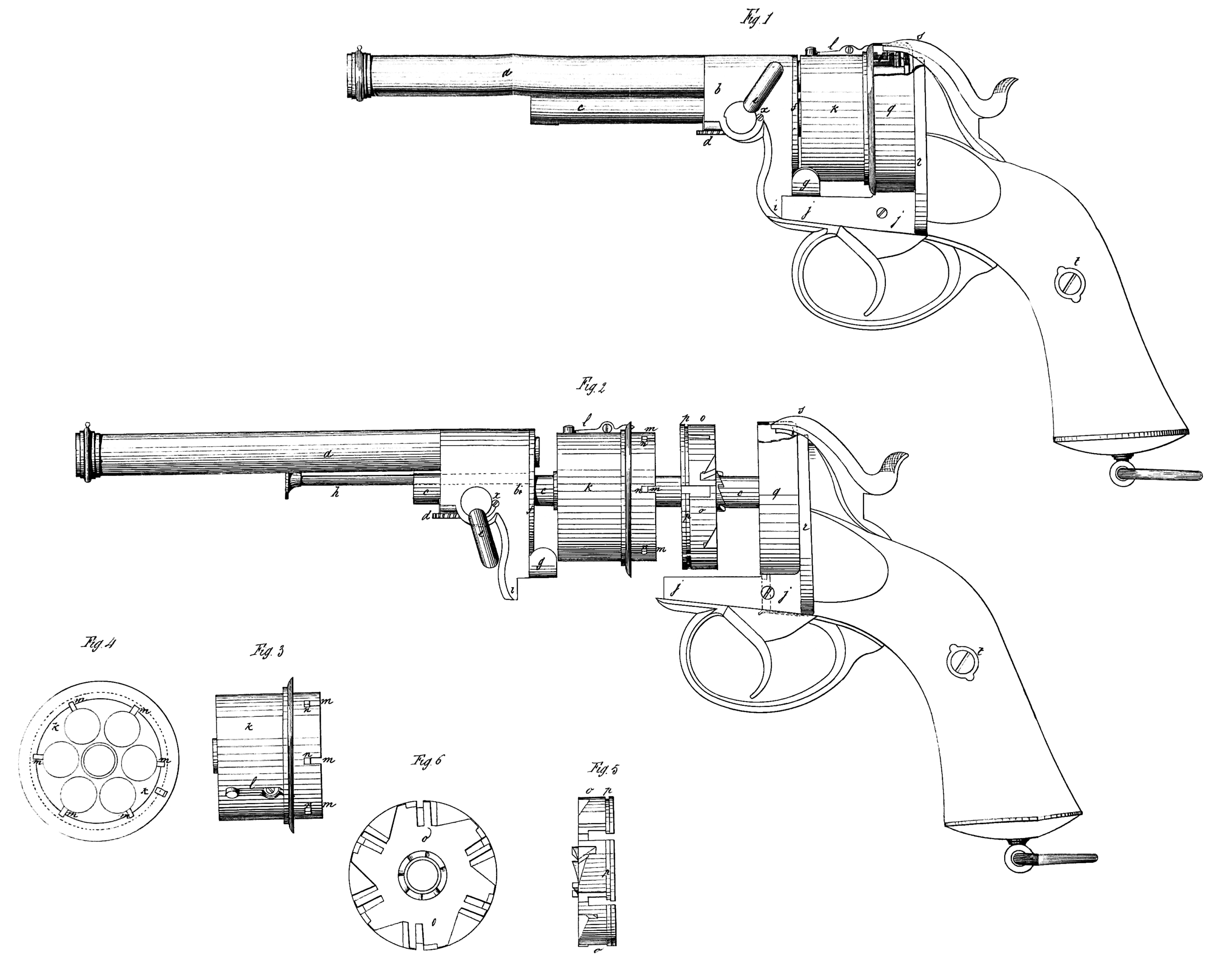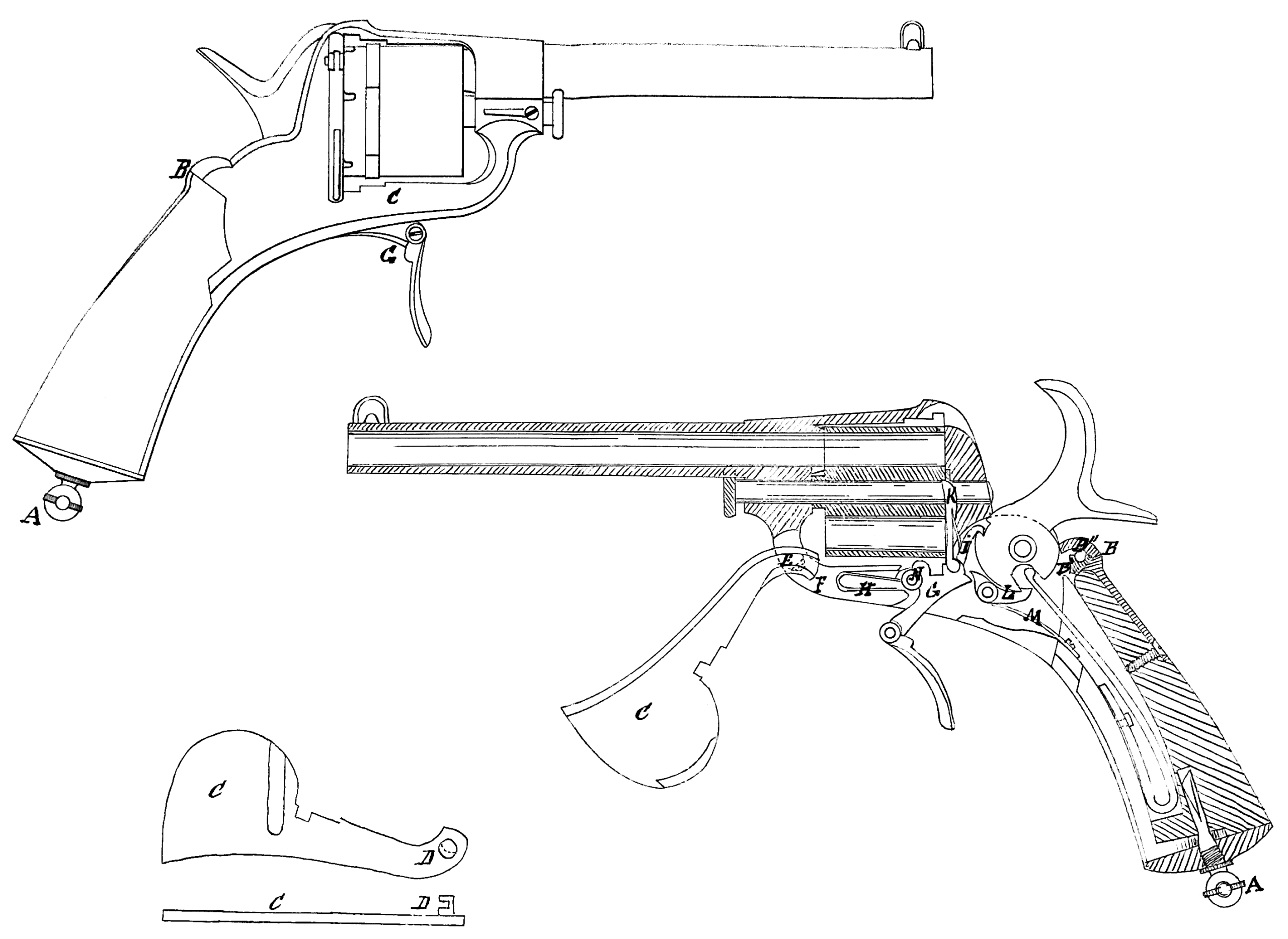Switzerland 16925
SCHWEIZERISCHE EIDGENOSSENSCHAFT
EIDGEN. AMT FÜR GRISTIGES EIGENTUM
PATENTSCHRIFT
Patent Nr. 16925
10. Mai 1898, 6 Uhr, p.
Klasse 112
Franz MESSEDAT, in Köln (Deutschland).
Schutzrevolver für Fahrräder.
Mein Schutzrevolver für Fahrräder ist in der beiliegenden Zeichnung in beispielsweiser Ausführungsform durch Fig. 1 und 2 in Oberansicht mit abgenommenem Deckel,
Fig. 3 in Querschnitt nach x— x in Fig. 1 und
Fig. 4 in Seitenansicht dargestellt;
Fig. 5 ist ein Detail.
Radfahrer haben sehr häufig unter dem Angriff von Hunden zu leiden und sind dadurch vielen Gefahren ausgesetzt.
Diesen Gefahren zu begegnen, soll der vorliegende Revolver dienen, durch den blinde Schüsse abgegeben werden können, welche den oder die Hunde verscheuchen.
Der an passender Stelle, am besten auf der Lenkstange l, des Fahrrades angebrachte Revolver besteht aus der schalenartigen Grundplatte a, auf welcher die an ihrem oberen Rande, sowie auch auf ihrem Mantel mit Sperrzähnen b¹, bezw. b² ausgerüstete Patronenkammer b drehbar befestigt ist.
Diese Patronenkammer b ist in der beigegebenen Zeichnung beispielsweise zur Aufnahme von 10 Patronen eingerichtet.
In die Zähne b² greift eine unter Wirkung einer Feder e! stehende Sperrklinke c, welche an einem Arm d eines um d² drehbaren Hebels d, d¹ gelenkig befestigt ist.
Der über die Grundplatte vorstehende Arm d¹ dient als Handhabe. Auf den Arm d wirkt eine Feder d³, welche denselben stets in seiner in Fig. 1 gezeichneten Lage zu halten, bezw. zurückzuführen sucht.
Zieht man an dem Arm d¹, so wird der Arm d aus der in Fig. 1 gezeichneten Stellung in die in Fig. 2 veranschaulichte geführt, dabei das Patronenmagazin b um die Größe eines Zahnes b² gedreht und gleichzeitig die Feder d³ gespannt. Läßt man den Arm d! los, so führt die Feder d³ die Sperrklinke c, sowie Hebel d, d¹ in ihre ursprüngliche Lage (Fig. 1) zurück und die Feder c¹ bringt die Nase der Klinke ce wieder zum Eingriff mit einem Sperrzahn b².
Der das Abschließen der Platzpatronen bewirkende, mit Spitze f¹ ausgerüstete Schlagbolzen f ist in einer Stütze e geführt, wobei der Bolzen f aufdem unteren Arm i der Stütze e ruht und mit seiner Schlagspitze f¹ über die untere Fläche des Armes i vorsteht. Der Arm i ist in einem Schlitz e! der Rückwand der Stütze e verschiebbar und liegt mit einer passend gestalteten Fläche auf der gebogenen Fläche eines Sperrzahns b¹ des Patronenmagazins b. Beim Drehen des letzteren mittelst des
Hebels d, d¹ wird durch den jeweiligen, sich mit der geneigten Fläche des Armes i in Eingriff befindenden Sperrzahn b¹ der Arm angehoben und dadurch die über den Bolzen f geschobene Feder f² gespannt. Nachdem die Spitze des Sperrzahns die gebogene Fläche des Armes i verlassen hat, wird letzterer durch die Feder f² niedergeschnellt und dadurch mittelst des Schlagstiftes f¹ eine Patrone zum Abschuß gebracht. Die Schale a besitzt unter dem Schlagbolzen f eine Öffnung a¹ (Fig. 5), um dem Pfropfen und den Pulvergasen der abgeschossenen Patrone ungehinderten Abzug zu gestatten. Seitlich dieser Öffnung a! sind zweckmäßig noch eine oder mehrere Öffnungen in der Schale a vorgesehen, um eventuell ein Losstoßen der Patronenhülsen von unten zu ermöglichen.
Durch Verstellen des auf der Stütze e drehbar befestigten Winkelhebels h läßt sich der Arm i anheben und feststellen, so daß alsdann der Revolver in Ruhe gesetzt ist.
Die ganze Einrichtung wird durch ein Gehäuse g, welches zweckmäßig als Glocke ausgebildet ist, eingeschlossen. Letztere ist mittelst der an ihr befestigten Feder g¹ mit der Schale a durch die umgebogenen Enden g² und den Stift g³ lösbar verbunden. Die Glocke g wird durch den mit Handhabe und Klöppel ausgerüsteten Hebel m bethätigt und dient gleichzeitig als Signalglocke.
Das Füllen des Magazins mit Patronen, sowie das Fortschaffen der Hülsen erfolgt nach Abnahme der Glocke g. Dieses Abnehmen ist sehr einfach und genügt es, mittelst des Stiftes g³ das eine gebogene Ende g² der Feder g¹ aus seiner Öffnung zu drücken, um die Glocke abheben zu können.
PATENT-ÄNSPRÜCHR:
1. Ein Schutzrevolrer für Fahrräder, dadurch gekennzeichnet, daß die auf einer Schale a drehbar gelagerte Patronenkammer b sowohl mit Sperrzähnen b² zum Drehen der Kammer 5 mittelst des Hebels d, d¹ und der Sperrklinke c, als auch mit Sperrzähnen b¹ zum Anheben des Schlagbolzens f und Spannen der auf demselben sitzenden Feder f² ausgerüstet ist;
2. Ein Schutzrevolver nach Anspruch 1, wobei die Mechanismen durch ein als Signalglocke ausgebildetes, abnehmbares Gehäuse eingeschlossen sind.
Franz MESSEDAT.
Vertreter: A. GLOOR, in Zürich.

